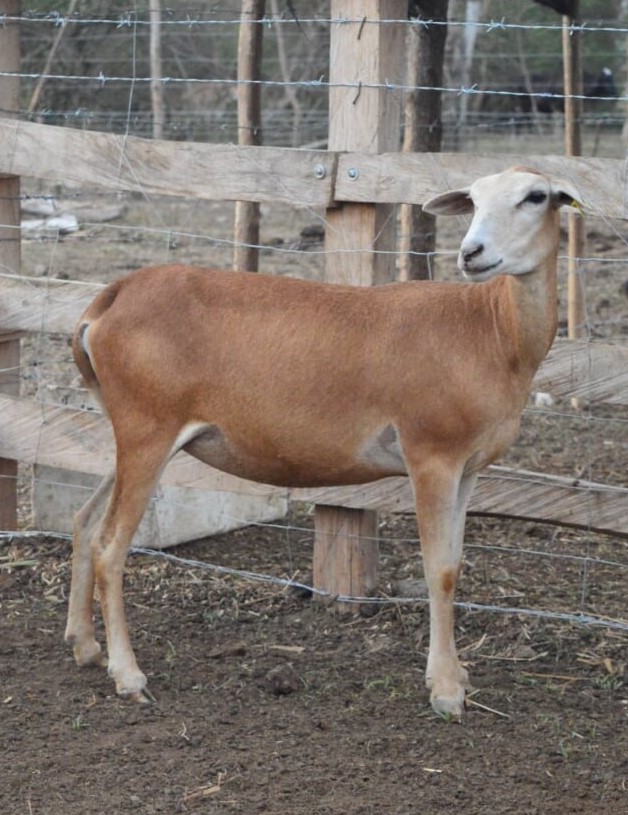Morphostructural characterization and zoometric indices of Sudan females Colombian Creole Hair sheep “OPC”
Caracterización morfoestructural e índices zoométricos de hembras Ovino de Pelo Criollo Colombiano “OPC” Sudán

Show authors biography
Objective. This study aimed to describe body measurements and zoometric indices of Colombian creole woolless sheep (OPC), in two of its varieties, Sudan Bayo and Sudan Blanco. Materials y methods. This research was carried out in the states of Córdoba, Cesar, and La Guajira. Two farms were visited in Córdoba and Cesar and one in La Guajira. In each state were evaluated 21, 75, and 14 animals, respectively. In 110 Sudan sheep were studied 29 morphostructural variables and body weight; with these variables, 15 zoometric indices were estimated. To the collected information, descriptive statistics were applied through the InfoStat® software. Results. Sudan Bayo presented higher values in body weight than Sudan Blanco sheep (40.8 and 40.57 kg), as in the zoometric measurements related to head, limbs, and most of the trunk; for the first sheep variety 83 ewes were used and 27 animals for the second variety. Regarding the zoometric indices, Sudan sheep were characterized for being dolichocranial, dolichocephalic, eumetric, with a thorax of elliptical tendency, with convex rumps, and of longilineal body according to two ethnological indices while brevilineal based on one functional index. Conclusions. Through this research, the current morphometric status of Sudan OPC was known in detail, as well as the proportionality between the body regions, whose inclination is towards the meat biotype.
Article visits 2163 | PDF visits
Downloads
- Delgado JV, Perez Grovas R, Camacho ME, Fresno M, Barba C. The Wool-less Canary sheep and their relationship with the present breeds in America. Anim Genet Resour. 2000; 28:27-34. https://doi.org/10.1017/S1014233900001334
- Vivas Ascue NJ. Diversidad Genética de Ovinos Criollos Colombianos. [Tesis M.Sc.]. Palmira: Universidad Nacional de Colombia Sede; 2013. URL Disponible en: http://bdigital.unal.edu.co/12683/
- Flórez Murillo JM, Hernández Pérez M de J, Bustamante Yánez M de J, Vergara Garay OD. Caracterización morfoestructural de tres poblaciones de Ovino de Pelo Criollo Colombiano “OPC”. Arch Zootec. 2018; 67(259):340-348. https://doi.org/10.21071/az.v67i259.3789
- Arredondo BJV, Rivera DF, Hernández HDY. Tipología morfoestructural de la hembra ovina de pelo criollo colombiano en Quindío y Valle del Cauca. REDVET. 2017; 18(12):1-15.
- Ocampo RJ, Martínez RA, Rocha JF, Cardona H. Genetic characterization of Colombian indigenous sheep. Rev Colomb Cienc Pecu. 2017; 30(2):116-125. https://revistas.udea.edu.co/index.php/rccp/article/view/325659
- Ángel S, Ramírez A. Estudio zoométrico del ovino de pelo criollo colombiano de la zona norte del departamento del Huila (Colombia). AICA 2014; 4:338-340. http://www.uco.es/conbiand/aica/templatemo_110_lin_photo/articulos/2014/Trabajo058_AICA2014.pdf
- Moreno MJ, Montes VD, Ucrós PJ, Fernández QA, Cardona ÁJ. Variabilidad morfoestructural de la hembra ovina de pelo criollo colombiana. Livestock Res Rural Dev. 2013; 25(5). http://www.lrrd.cipav.org.co/lrrd25/5/more25083.htm
- Yunusa AJ, Salako AE, Oladejo OA. Morphometric characterization of Nigerian indigenous sheep using multifactorial discriminant analysis. IJBC 2013; 5(10):661-665. http://citeseerx.ist.psu.edu/viewdoc/download?doi=10.1.1.876.2246&rep=rep1&type=pdf
- Popoola MA. Zootechnical Index Analysis of West African Dwarf Rams in Southwestern Nigeria. ATS 2015; 48(1-2):24-29. https://doi.org/10.1515/ats-2015-0004
- Morales-delaNuez A, Rodríguez C, Santana M, Hernandez-Castellano LE, Niño T, Reyes-Chacon RJ, et al. Morphological measurements and indexes as a tool to support molecular genetic studies: an example in Canary Islands. J Appl Anim Res. 2012; 40(3):215-221. https://doi.org/10.1080/09712119.2012.658062
- Bravo S, Sepúlveda N. Índices zoométricos en ovejas criollas Araucanas. Int J Morphol. 2010; 28(2):489-495. http://dx.doi.org/10.4067/S0717-95022010000200025
- Di Rienzo JA, Casanoves F, Balzarini MG, Gonzalez L, Tablada M, Robledo YC. InfoStat. Versión 2016. Argentina: Universidad Nacional de Córdoba; 2016.
- Arredondo V, Macedo R, Magaña JC, Molina J, Prado O, García LJ, et al. Variabilidad morfológica de la oveja Pelibuey en Colima, México. AICA 2013; 3:1-7. URL Disponible en: http://www.uco.es/conbiand/aica/templatemo_110_lin_photo/articulos/2013/Trabajo001_AICA2013.pdf
- Herrera M, Luque M. Morfoestructura y Sistemas para el Futuro en la Valoración Morfológica. En: Sañudo C dir. Valoración Morfológica de los Animales Domésticos. Madrid: Ministerio de Medio Ambiente y Medio Rural y Marino; 2009. https://www.mapa.gob.es/es/ganaderia/temas/zootecnia/LIBRO%20valoracion%20morfologica%20SEZ_tcm30-119157.pdf
- Biagiotti D, Rocha SJL, Oliveira do ÓA, Rêgo NA, Vieira G, da Silva NS, et al. Caracterização fenotípica de ovinos da raça Santa Inês no Estado do Piauí. Rev Bras Saúde Prod Anim. 2013; 14(1):29-42. http://dx.doi.org/10.1590/S1519-99402013000100004
- Vilaboa AJ, Bozzi R, Díaz RP, Bazzi L. Conformación corporal de las razas ovinas Pelibuey, Dorper y Katahdin en el estado de Veracruz, México. Zootecnia Trop. 2010; 28(3):321-328. http://www.bioline.org.br/pdf?zt10032
- León AL. Variables morfométricas del ovino Pelibuey Cubano adulto. Rev Prod Anim. 2008; 20(1):72-75. https://revistas.reduc.edu.cu/index.php/rpa/article/view/3017
- Álvarez S, Fresno M, Capote J, Delgado J, Barba C. Estudio para la caracterización de la raza ovina Canaria. Arch Zootec. 2000; 49(185):209-215. https://www.redalyc.org/articulo.oa?id=49518630
- Dzib CA, Ortiz A, Torres HG. Variabilidad morfoestructural de ovinos Blackbelly en Campeche, México. Arch Zootec. 2011; 60(232):1291-1301. http://dx.doi.org/10.4321/S0004-05922011000400044
- De la Rosa SA, Revidatti MA, Tejerina ER, Orga A, Cappello JS, Petrina JF. Estudio para la caracterización de la oveja criolla en la región semiárida de Formosa, Argentina. AICA. 2012; 2(1):87-94. http://www.uco.es/conbiand/aica/templatemo_110_lin_photo/articulos/2012/Trabajo041_AICA2012.pdf























